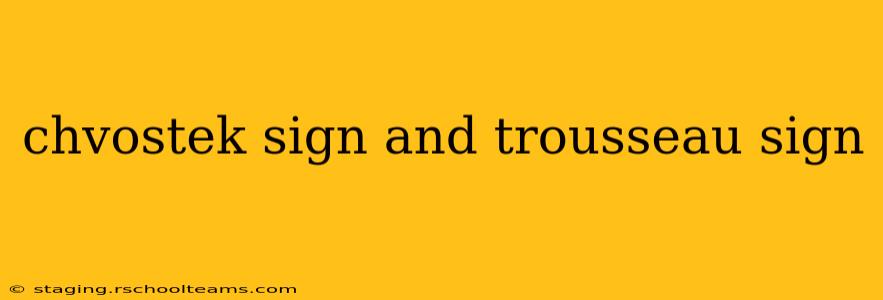This article explores Chvostek's sign and Trousseau's sign, two important clinical indicators often associated with hypocalcemia (low calcium levels in the blood). We'll delve into their causes, how they're elicited, and their significance in medical diagnosis.
What is Chvostek's Sign?
Chvostek's sign is a clinical finding characterized by facial muscle twitching in response to tapping the facial nerve. Specifically, a light tap over the facial nerve, usually anterior to the earlobe, just below the zygomatic arch, elicits a brief contraction of the ipsilateral (same side) facial muscles. This twitching typically involves the orbicularis oculi (muscle around the eye) and the muscles of the mouth.
How is Chvostek's Sign Elicited?
The examiner uses their fingers to gently tap the facial nerve. The response, if present, is usually rapid, occurring within a second or two of the tap. The intensity of the twitch can vary; sometimes it's a subtle flicker, while in other cases, it can be a more pronounced contraction.
Significance of Chvostek's Sign
Chvostek's sign is a relatively sensitive but not highly specific indicator of hypocalcemia. This means that while it frequently appears in individuals with low calcium, it can also occur in other conditions. Therefore, a positive Chvostek's sign necessitates further investigation to confirm the underlying cause. Conditions associated with a positive Chvostek's sign include:
- Hypoparathyroidism: A condition where the parathyroid glands don't produce enough parathyroid hormone (PTH), crucial for calcium regulation.
- Vitamin D deficiency: Inadequate vitamin D levels impair calcium absorption.
- Renal failure: Impaired kidney function affects calcium metabolism.
- Pancreatitis: Inflammation of the pancreas can disrupt calcium balance.
- Certain medications: Some medications can interfere with calcium metabolism.
What is Trousseau's Sign?
Trousseau's sign, another valuable clinical indicator, is characterized by carpopedal spasm (hand and foot cramping) induced by prolonged arterial ischemia (reduced blood flow). It's elicited by applying a blood pressure cuff to the upper arm, inflating it to a pressure above systolic blood pressure for several minutes (typically 3-5 minutes).
How is Trousseau's Sign Elicited?
The patient's blood pressure is measured, and then a blood pressure cuff is placed around their upper arm. The cuff is inflated to a pressure exceeding the patient's systolic blood pressure and maintained at this level for a few minutes. This reduced blood flow to the hand leads to hypocalcemia-induced tetany, which manifests as carpopedal spasm. The hand and fingers flex into a characteristic position often described as a "obstetrical hand."
Significance of Trousseau's Sign
Similar to Chvostek's sign, Trousseau's sign is a sensitive but not highly specific indicator of hypocalcemia. The presence of Trousseau's sign strongly suggests hypocalcemia and warrants further investigation to identify the underlying cause, echoing the conditions listed for Chvostek's sign.
Differentiating Chvostek's and Trousseau's Signs
While both signs point toward hypocalcemia, they differ in their method of elicitation and the type of response observed. Chvostek's sign is a localized facial muscle twitch, while Trousseau's sign involves a more generalized carpopedal spasm. The presence of either sign warrants further investigation to determine the cause of the hypocalcemia and to provide appropriate medical management.
Conclusion
Chvostek's sign and Trousseau's sign are valuable clinical tools used to assess for hypocalcemia. Although not definitive diagnoses in themselves, they serve as important indicators, prompting further investigation to uncover the underlying medical condition. Accurate interpretation and prompt medical evaluation are crucial to ensure appropriate treatment and prevent potentially serious complications. Always consult a healthcare professional for diagnosis and treatment of any medical concerns.
